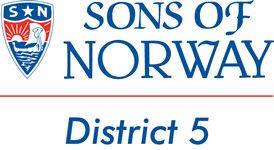Lodge Directory » Lodge Details
Grønnvik 632
Green Bay, Wisconsin
Meets 3rd Tuesday 6:30 p.m.
Trinity Lutheran Church
330 South Broadway Street
Green Bay, WI 54303
Trinity Lutheran Church
330 South Broadway Street
Green Bay, WI 54303
The History of Grønnvik 632
Grønnvik Lodge was formally instituted on June 2, 1994, with 49 members. At the charter banquet held in Oct. 1994, there were 69 members. Membership has been as high as 120 and in 2009 is around 90-100. Lorraine Selvick, Sturgeon Bay, a District 5 Director at the time, was instrumental is organizing this lodge.
Participating in public events is a great way to showcase Norwegian heritage to the community. Some opportunities the lodge has used include Kids and Culture of the Green Bay schools, Garden of Lights at the Green Bay Botanical Garden, Art Street, International Bayfest and displays at the Brown County Library.
Syttende Mai calls for a special celebration. At a 2008 joint meeting with neighboring lodge Norse Valley, participants learned about the services of the Norwegian-American Genealogical Library from director Blaine Hedberg. In 2007, Wisconsin author James R. Larson talked about his Viking era novels. Other programs have covered Edvard Grieg, Norway during World War II, Norwegians in the Civil War and Henrik Ibsens Norway.
Monthly programs educate members about many aspects of Norwegian culture. Classes have included rosemaling, knitting, Norwegian language and hardanger.
Each year during the November meeting, our best attended event, members offer new and traditional Norwegian dishes at A Taste of Norway. Its an opportunity to learn how to make a recipe, as well to enjoy a sample of the food.
In 2001, the lodge published its own cookbook Favorite Norwegian Recipes. The first printing of 200 sold very quickly and another 200 were printed and sold. The second edition of the cookbook was published in 2007, again with very good sales. On both occasions, members supported the project enthusiastically, and local bookstores carried the cookbook selling many of them to the general public. In addition to recipes of old and new favorites, the cookbook contained a great deal of other information. The food specialties of Norway are described, as well as how Norwegian immigrants adapted to the new foods they found in America. Many recipes included anecdotes and family traditions, and the project was a good fund raiser.
Heritage is passed to the next generation with family events like Juletrefest, picnics, hayrides and scholarships to a district-wide camp where children experience Norwegian culture.
Participating in public events is a great way to showcase Norwegian heritage to the community. Some opportunities the lodge has used include Kids and Culture of the Green Bay schools, Garden of Lights at the Green Bay Botanical Garden, Art Street, International Bayfest and displays at the Brown County Library.
Syttende Mai calls for a special celebration. At a 2008 joint meeting with neighboring lodge Norse Valley, participants learned about the services of the Norwegian-American Genealogical Library from director Blaine Hedberg. In 2007, Wisconsin author James R. Larson talked about his Viking era novels. Other programs have covered Edvard Grieg, Norway during World War II, Norwegians in the Civil War and Henrik Ibsens Norway.
Monthly programs educate members about many aspects of Norwegian culture. Classes have included rosemaling, knitting, Norwegian language and hardanger.
Each year during the November meeting, our best attended event, members offer new and traditional Norwegian dishes at A Taste of Norway. Its an opportunity to learn how to make a recipe, as well to enjoy a sample of the food.
In 2001, the lodge published its own cookbook Favorite Norwegian Recipes. The first printing of 200 sold very quickly and another 200 were printed and sold. The second edition of the cookbook was published in 2007, again with very good sales. On both occasions, members supported the project enthusiastically, and local bookstores carried the cookbook selling many of them to the general public. In addition to recipes of old and new favorites, the cookbook contained a great deal of other information. The food specialties of Norway are described, as well as how Norwegian immigrants adapted to the new foods they found in America. Many recipes included anecdotes and family traditions, and the project was a good fund raiser.
Heritage is passed to the next generation with family events like Juletrefest, picnics, hayrides and scholarships to a district-wide camp where children experience Norwegian culture.

